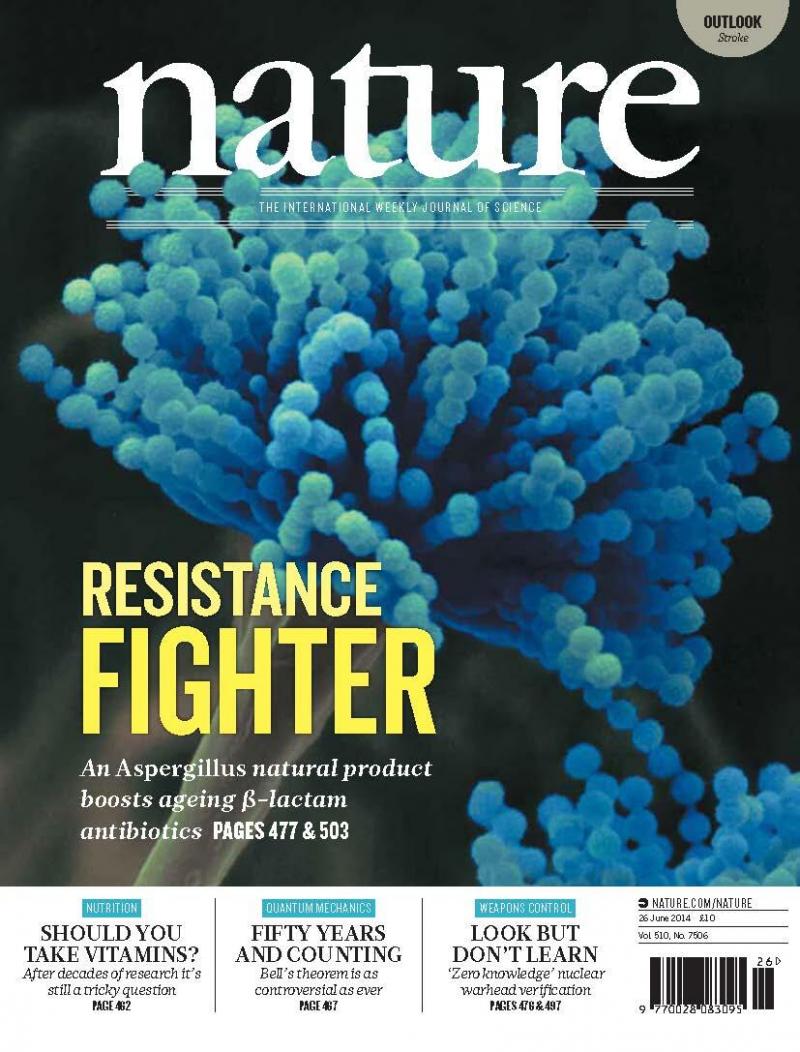According to the Centers for Disease Control, drug-resistant bacteria cause more than two million infections, and kill at least 23,000 people every year in the United States. At the same time, the development of new antibiotics has slowed to a trickle, partially because pharmaceutical companies know that the inevitable emergence of resistance will cut short the useful lifespan of any drug they develop. (As I explained in part 1, optimism about eradicating disease through the use of antibiotics should have been tempered by what evolution predicted about the emergence of antibiotic resistance in bacteria.)
 And that’s why “Aspergillomarasmine A overcomes metallo-β-lactamase antibiotic resistance,” cover article of the June 25 issue of Nature, despite its obscure title, is so important. It points the way toward a not entirely new but certainly underutilized way of thinking about antibiotic development and utilization: combination therapy. The compound described in the paper—aspergillomarasmine A, or AMA for short—restores the effectiveness of antibiotics against bacteria that make a particularly powerful resistance enzyme called NDM-1. NDM-1 resistance has emerged quite recently, and it is especially dangerous because it provides resistance not to just one antibiotic, but to an entire class. It inactivates all of the so-called beta-lactam antibiotics, a group that includes penicillin, ampicillin, and cephalosporin. AMA works by inactivating NDM-1; when given in combination with a beta-lactam antibiotic, it restores the antibiotic’s effectiveness.
And that’s why “Aspergillomarasmine A overcomes metallo-β-lactamase antibiotic resistance,” cover article of the June 25 issue of Nature, despite its obscure title, is so important. It points the way toward a not entirely new but certainly underutilized way of thinking about antibiotic development and utilization: combination therapy. The compound described in the paper—aspergillomarasmine A, or AMA for short—restores the effectiveness of antibiotics against bacteria that make a particularly powerful resistance enzyme called NDM-1. NDM-1 resistance has emerged quite recently, and it is especially dangerous because it provides resistance not to just one antibiotic, but to an entire class. It inactivates all of the so-called beta-lactam antibiotics, a group that includes penicillin, ampicillin, and cephalosporin. AMA works by inactivating NDM-1; when given in combination with a beta-lactam antibiotic, it restores the antibiotic’s effectiveness.
Two things are noteworthy about this discovery. First, AMA was discovered in a very old-fashioned way—by screening thousands of small molecules produced by bacteria and fungi found in soil. That the authors’ laboratory was able to find such a compound relatively quickly suggests that many such potential antibiotic sidekicks have probably already been “discovered” by microbes during their multi-billion year evolutionary journey.
The other notable feature of this research is that in their search for natural compounds, the authors added a wrinkle to the old approach. They didn’t look for a compound that would kill bacteria—they looked for a compound that would counteract NDM-1 resistance. Evolutionarily, such a strategy is powerful. If you use a compound that kills, the selective pressure for a resistant variant is intense. By contrast, if you find a compound that blocks resistance without killing the bacteria, you put the bacteria in an evolutionary bind: to counteract both drugs, the NDM-1 must mutate in such as way as to protect itself from AMA, but retain its ability to destroy antibiotics. Like a high diver adding a double twist to a triple flip, this significantly ups the degree of evolutionary difficulty.
Just as a side note, this same evolutionary thinking explains why combination therapy was so successful in the treatment of HIV. When anti-viral drugs with different viral targets were given singly or in succession, resistant variants quickly developed. When the same drugs were given in triple combination, the probability that a single virus would mutate in such a way as to evade all three drugs dropped to near zero.
While many hurdles must yet be overcome before AMA becomes an approved drug, its discovery has implications beyond this single molecule. Taking the approach of screening natural compounds for their ability to block common resistance mechanisms has great potential, especially since combination therapy may dramatically extend the life of new antibiotic drugs—thus making their development more economically attractive.
We mustn’t be naïve. Bacteria will eventually develop resistance even to potent drug combinations—in an evolutionary horse-race between bacteria and drugs, I would always place my money on the bugs—but combination therapy could dramatically stretch the lifetime of our most powerful anti-bacterial drugs, and save a lot of lives. Understanding evolution pays off.

